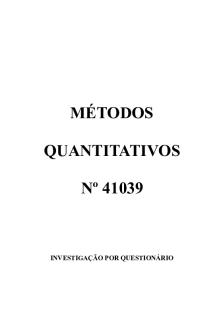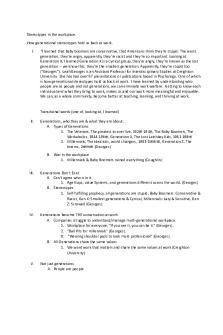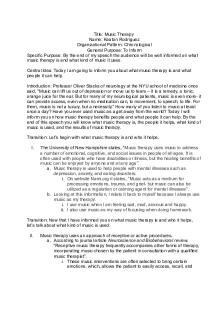Sandra Day O Connor- Informative PDF

| Title | Sandra Day O Connor- Informative |
|---|---|
| Author | Laura Horton |
| Course | Public Speaking |
| Institution | Wake Forest University |
| Pages | 4 |
| File Size | 100.1 KB |
| File Type | |
| Total Downloads | 18 |
| Total Views | 134 |
Summary
Informative Speech...
Description
Horton 1
Laura Horton Section H Informative Speech Outline Sandra Day O’Connor Specific Purpose: I will inform my audience about the first female Supreme Court Justice Sandra Day O’Connor. Central Idea: Sandra Day O’Connor is an important American figure because of her inspiring journey to the Supreme Court, her accomplishments while serving as a justice, and her lasting impact on the United States and its people. Introduction: I. Attention Grabber: When I was a little girl my parents always told me I was going to grow up to be a lawyer because I LOVED to argue. Now, I work at the law school and do plan to pursue a law degree. However, I don’t simply want to be a lawyer. I want to be the first female Supreme Court Chief Justice. For this reason, Sandra Day O’Connor, the first female Supreme Court justice, is my role model. II. Topic: Sandra Day O’Connor was the United States’ first female Supreme Court Justice. III. Credibility Statement: I aspire to be a Supreme Court Justice, so I have done extensive research into O’Connor’s journey to the Supreme Court and her time serving as a justice. IV. Relevancy Statement: Her story is relevant to college students because we are all affected by the decisions of the U.S. Supreme Court. V. Preview: I will begin by discussing Sandra Day O’Connor’s inspiring journey to the Supreme Court, next I will share her accomplishments while serving as a justice, and I will conclude with her lasting impact on the United States and its people. Transition: O’Connor’s journey to the Supreme Court was not an easy one. Body: I. Journey: Being a woman in the 1950s, O’Connor’s journey to the Supreme Court was more difficult than those of her male colleagues due to gender bias. A. O’Connor had to work hard as a young woman to stand out intellectually against her fellow male students. 1. At age 16, she was admitted to Stanford University (Abraham, 2008). 2. After just 2 years, she graduated 3rd in her class from Stanford Law School (Ginsburg, 2006). B. Despite her impeccable qualifications, O’Connor worked without pay for the County Attorney of California’s San Mateo Region to get her foot in the door (Pacelle, 2001). 1. She turned down a paid position as the legal secretary.
Horton 2
2. After proving herself, she got a job as the Deputy County Attorney. Transition: O’Connor worked as an attorney, a senator, and a judge before her appointment by President Ronald Reagan and unanimous approval by the Senate to become the first female Supreme Court Justice in 1981(Smentkowski, 2018). II.
Accomplishments: While serving as a justice, O’Connor wrote many important majority opinions and was often the swing vote in divisive cases. A. O’Connor wrote the majority opinion for the 5-4 decision in the 1982 Mississippi University for Women v. Hogan case in which Hogan sued after being denied admission to a traditionally all-female school. 1. O’Connor explained that the school was perpetuating the stereotype that nursing was strictly a woman’s job; therefore, the school must admit qualified men (Mississippi University for Women v. Hogan, 1982). 2. Her opinion set the precedent for the 1996 case United States v. Virginia, in which the court ruled in a 7-1 decision that VMI’s male-only admissions policy was unconstitutional (United States v. Virginia, 1996). B. O’Connor was the swing vote that reaffirmed Roe v. Wade in the 1992 Planned Parenthood of Southeastern Pennsylvania v. Casey case (Planned Parenthood of Southeastern Pennsylvania v. Casey, 1992). 1. O’Connor was known to be an unpredictable voter, and despite the Republican push to overturn Roe v. Wade, she chose to promote women’s interests. 2. Her opinion imposed a new standard for determining the validity of laws restricting abortions called the “undue burden” test. Transition: O’Connor retired from the Supreme Court in 2006 to allow more time to take care of her husband, who was diagnosed with Alzheimer’s disease (McGregor, 2006).
III.
Impact: O’Connor continues to impact the United States and its people. A. O’Connor inspires youth to participate in government and civic engagement (Biskupic, 2016). 1. She founded iCivics, a website which provides creative and effective teaching tools to learn about civic engagement. 2. O’Connor made many public appearances to encourage youth to participate in government. B. Important rulings on university affirmative action and abortion rights rely on precedents set by O’Connor. 1. In the 2013 Fisher v. University of Texas case, the court reaffirmed that the Equal Protection Clause of the 14th Amendment permits the consideration of race in admissions decisions by using O’Connor’s opinion from the
Horton 3
2003 Grutter v. Bollinger case, (Fisher v. University of Texas , 2013) in which she stated that the Constitution does not prohibit the use of race in admissions decisions “to further a compelling interest in obtaining the educational benefits that flow from a diverse student body” (Grutter v. Bollinger, 2003). 2. In the 2016 Whole Woman’s Health v. Hellerstedt case, O’Connor’s “undue burden” test was applied to determine that Texas’ House Bill 2 was unconstitutional (Whole Woman’s Health v. Hellerstedt, 2016). Transition: O’Connor will continue to influence the American people for many years to come. Conclusion: I. Summary: Sandra Day O’Connor is an important American figure because of her difficult journey as a female lawyer in the 1950s, her influence in numerous, divisive Supreme Court cases, and her lasting impact on the American youth’s participation in civic engagement. II. Clincher: Sandra Day O’Connor inspired my dream of becoming a Supreme Court justice, and I hope that one day I can be as influential as her.
Horton 4
References Abraham, H. J. (2008). Justices, Presidents, and Senators: A History of the U.S. Supreme Court Appointments from Washington to Bush II (5. new and rev. ed). Lanham, Md.: Rowman &
Littlefield.
Biskupic, J. (2016). The summer of Sandra Day O’Connor, then and now. Retrieved September 20, 2018, from https://www.cnn.com/2016/08/20/politics/sandra-day-o-connor-legacy/index.html Fisher v. University of Texas, 570 U.S. __ (2013) Grutter v. Bollinger, 539 U.S. 306 (2003) Ginsburg, R. B. (2006). [Sandra Day O’Connor]. Harvard Law Review, 119(5), 1239–1242. Retrieved September 20, 2018, from http://www.jstor.org/stable/4093567 McGregor, R. V. (2006). [Sandra Day O’Connor]. Harvard Law Review, 119(5), 1245–1247. Retrieved September 20, 2018, from https://www.jstor.org/stable/4093569 Mississippi University for Women v. Hogan, 458 U.S. 718 (1982) Planned Parenthood of Southeastern Pennsylvania v. Casey, 505 U.S. 833 (1992) Pacelle, R. L. (2001). [Review of Review of The Rehnquist Court and the Constitution, by T. E. Yarbrough]. The American Historical Review, 106(3), 1021–1022. https://doi.org/10.2307/2692440 Smentkowski, B. (2018). Sandra Day O’Connor -- Britannica Academic. Retrieved September 20, 2018, from https://academic.eb.com/levels/collegiate/article/Sandra-Day-OConnor/56723 United States v. Virginia, 518 U.S. 515 (1996) Whole Woman’s Health v. Hellerstedt, 579 U.S. __ (2016)...
Similar Free PDFs

Sandra Day O Connor- Informative
- 4 Pages

O\' Connor v Oakhurst Dairy
- 1 Pages

Trabajo Simbología Sandra
- 4 Pages

Day 1 - Day 1
- 2 Pages

Graham v Connor - Case Brief
- 1 Pages

Sandra littlefield concept map
- 2 Pages

Apontamentos HES - sandra
- 106 Pages

Sandra Littlefield Care Plan
- 12 Pages

MQT Resumo Matéria - sandra
- 47 Pages

Informative Speech
- 3 Pages

Informative speech
- 3 Pages
Popular Institutions
- Tinajero National High School - Annex
- Politeknik Caltex Riau
- Yokohama City University
- SGT University
- University of Al-Qadisiyah
- Divine Word College of Vigan
- Techniek College Rotterdam
- Universidade de Santiago
- Universiti Teknologi MARA Cawangan Johor Kampus Pasir Gudang
- Poltekkes Kemenkes Yogyakarta
- Baguio City National High School
- Colegio san marcos
- preparatoria uno
- Centro de Bachillerato Tecnológico Industrial y de Servicios No. 107
- Dalian Maritime University
- Quang Trung Secondary School
- Colegio Tecnológico en Informática
- Corporación Regional de Educación Superior
- Grupo CEDVA
- Dar Al Uloom University
- Centro de Estudios Preuniversitarios de la Universidad Nacional de Ingeniería
- 上智大学
- Aakash International School, Nuna Majara
- San Felipe Neri Catholic School
- Kang Chiao International School - New Taipei City
- Misamis Occidental National High School
- Institución Educativa Escuela Normal Juan Ladrilleros
- Kolehiyo ng Pantukan
- Batanes State College
- Instituto Continental
- Sekolah Menengah Kejuruan Kesehatan Kaltara (Tarakan)
- Colegio de La Inmaculada Concepcion - Cebu




